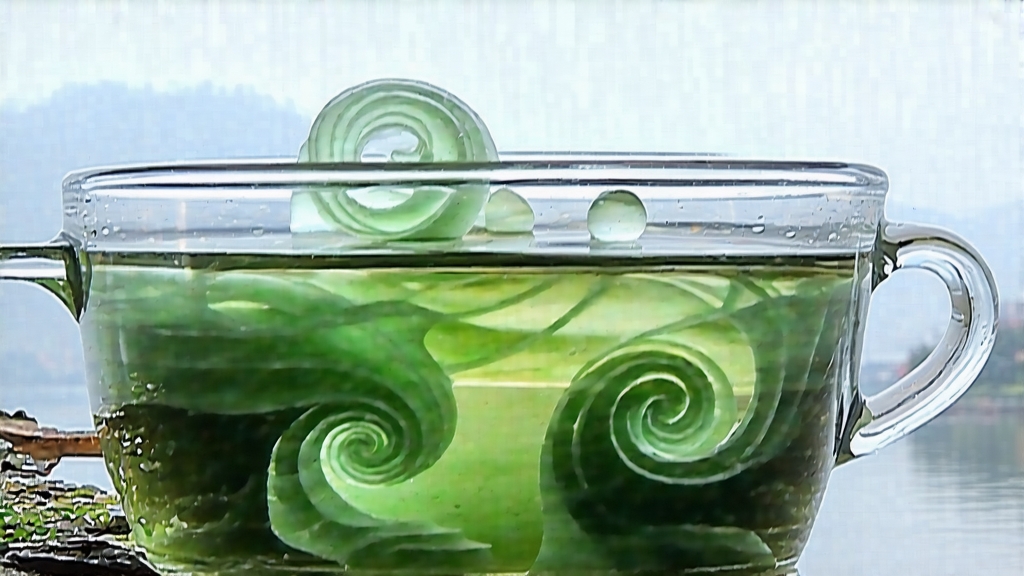
Biluochun, whose name translates literally to “Green Snail Spring,” is one of China’s ten most celebrated teas, yet it remains a quiet mystery outside serious tea circles. Grown on the mist-locked, fruit-tree-capped hills that rim eastern Taihu Lake in Jiangsu Province, this emerald-green tea is prized for its improbably tiny spiral, an aroma that carries the scent of peach and apricot blossoms, and a cup that tastes like early morning in a mountain orchard. To understand Biluochun is to follow a thread that begins in the Tang dynasty, passes through imperial tribute, survives twentieth-century wars, and lands in the modern glass of any curious drinker willing to treat it with patience rather than spectacle.
Historical whispers place the tea’s birth during the reign of Emperor Suzong (756-762). A monk from Dongting Mountain is said to have offered an unnamed “astringent herb” that miraculously cured the sovereign’s fever. The grateful court named the tea “Xia Sha Ren Xiang”—“Scary-fragrant”–because its perfume was almost too piercing for the palace. The name stuck until the Kangxi Emperor toured the south in 1699. Presented with the same tea, he found the title vulgar and rechristened it Biluochun for its snail-like roll and spring harvest. From that moment the tiny leaves entered the Qing tribute list, leaving Jiangsu on fast barges bound for the Forbidden City.
Geography explains the flavor. Dongting Mountain is actually two islands—East and West—anchored inside the vast freshwater Taihu Lake. The micro-climate is a natural greenhouse: 300 foggy days a year, humidity hovering at 80 %, and temperature swings moderated by the lake’s thermal mass. Peach, plum, loquat and persimmon trees grow between tea bushes; their roots intermingle, their blossoms fall onto the leaf, and their volatile esters are absorbed by the dormant bud. No other Chinese green is co-cultivated with fruit on a commercial scale, which is why professional cuppers often detect notes of nectarine skin and why Japanese researchers have identified the rare lactone compound γ-decalactone in measurable levels.
The cultivar itself is a small-leaf Camellia sinensis var. sinensis locally called “Dongting Qunti.” Unlike modern clonal gardens, these bushes are seed-propagated, giving each plant subtle genetic drift. Farmers prize the heterogeneity; it lengthens the picking window and layers complexity into the final aroma. Bushes are kept waist-high, pruned into a gentle dome that encourages lateral buds—the only ones considered tender enough for true Biluochun.
Plucking rules are stricter than any other green tea. The standard is “one bud with one just-opened leaf” no longer than 2.5 cm, picked before Qingming festival when the spring dew is still cold. A skilled picker gathers barely 500 g of fresh leaf in a day; 6.5 kg of this is needed to produce 1 kg of finished tea. The pluck is placed in shallow bamboo trays lined with mosquito-net silk so that no pressure bruises the leaf edge. Within three hours it must reach the firing hut, otherwise the signature fruity note will oxidize into bland grass.
Traditional crafting is a duet between hand and wok that lasts exactly seven minutes. The wok is first heated to 190 °C, then rubbed with a lump of local tung oil and a handful of fresh tea leaves to season the surface. Once the temperature drops to 80 °C, 250 g of fresh leaf is thrown in. The maker uses three motions—“grab, shake, rub”—to drive off moisture without burning the downy tip. After three minutes the leaf is removed, allowed to cool for thirty seconds, then re-fired at 60 °C while the hand pressure increases, coaxing the tiny spiral. The final thirty seconds are the most perilous: the wok is raised to 100 °C and the leaves are rolled against the iron with a whiplash motion that sets the curl. When done correctly the finished leaf looks like a jade snail shell covered in microscopic white hairs; if the heat lingers a second too long, those hairs turn ochre and the aroma collapses.
Modern factories replicate the process with drum heaters and controlled humidity, but the highest grades—Special Grade #1 and Pre-Qingming Guan—are still hand-made by certified masters whose palms are thickly calloused yet sensitive enough to feel a 1 °C change in metal temperature. Each master’s batch is cupped by a